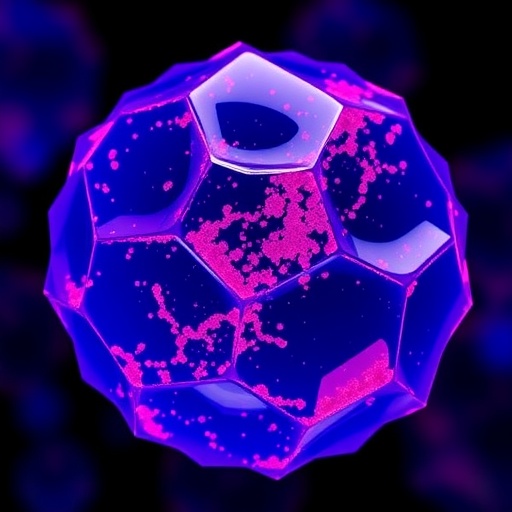In the rapidly evolving field of environmental science, innovative solutions are constantly sought to address the pressing issues of pollution and waste management. A recent study has shed light on a particularly promising method for removing the dye Indigo Carmine from wastewater. This research, conducted by a team of experts, focuses on the development of ionotropic metal-doped chitosan hydrogels, which demonstrate remarkable efficacy in tackling this prevalent environmental pollutant.
Chitosan, a biopolymer derived from chitin found in the shells of crustaceans, has long been recognized for its biodegradable, non-toxic properties and its ability to form hydrogels. However, the introduction of metal ions into the chitosan matrix has given rise to a new generation of hydrogels with enhanced properties. The incorporation of these inorganic elements enhances the interaction between the hydrogel and various pollutants, resulting in a more effective adsorption process. The versatility of chitosan, combined with the tuning effects of metal doping, presents a unique approach to environmental remediation.
The study meticulously explores the process of synthesizing these hydrogels. By varying the concentration of metal ions during the hydrogel formation, the researchers managed to significantly influence the properties of the final product. This careful calibration allows for the optimization of the hydrogels, ensuring they possess the most effective surface characteristics for adsorbing dye molecules. The findings indicate that certain metal ions, when doped into chitosan, significantly boost the gel’s ability to interact and bind with Indigo Carmine particles.
The adsorption mechanism is complex and involves multiple interactions. The researchers have provided a detailed analysis of how metal ions alter the surface charge, porosity, and overall structure of the chitosan hydrogels. These alterations facilitate greater interactions with the Indigo Carmine dye, which is notorious for its resistance to traditional removal methods. Through a series of controlled experiments, the team has demonstrated that the optimized hydrogels offer superior performance in removing this dye from aqueous solutions.
One significant aspect highlighted in the study is the kinetics of dye adsorption on the hydrogels. The researchers employed a variety of models to assess how quickly and effectively the Indigo Carmine dye is taken up by the hydrogels. The results revealed that the adsorption process followed pseudo-second-order kinetics, indicating that the synthesis of hydrogels substantially enhances the rate at which dye is removed from contaminated water. This information is crucial for practical applications in wastewater treatment, as it allows for predictions about how these hydrogels can be employed in real-world scenarios.
Additionally, the study delves into the reusability of these ionotropic metal-doped chitosan hydrogels, which is a critical factor for sustainable applications. The ability to regenerate the hydrogels after use greatly enhances their practicality and cost-effectiveness. The researchers found that even after multiple cycles of use, the hydrogels maintained their structural integrity and efficiency in dye adsorption. This reusability factor is essential in developing viable solutions for large-scale wastewater management.
Furthermore, the environmental implications of utilizing metal-doped chitosan hydrogels are expansive. By effectively removing hazardous dyes like Indigo Carmine from industrial effluents, this innovative approach provides a dual benefit: improving water quality and reducing the harmful impacts of dye pollutants on aquatic ecosystems. Given the global concern over water scarcity and pollution, the findings underscore the potential of these hydrogels to contribute to a more sustainable future.
Another compelling angle of the research is the potential customization of the hydrogels for specific applications. By altering the types and concentrations of metal ions, it is feasible to engineer hydrogels that target different pollutants beyond Indigo Carmine. This flexibility may open up new avenues in environmental science, particularly in tackling a wider range of toxic dyes and industrial chemicals.
The researchers have also acknowledged the importance of scaling up this technology for industrial applications. While the results are promising, further studies are required to evaluate the performance of these hydrogels in larger systems and over extended periods. Real-world applications will involve navigating challenges such as varying pollutant concentrations, complex mixtures, and the overall cost of materials and production processes.
In conclusion, this groundbreaking research represents a significant step forward in addressing environmental pollution challenges through innovative materials science. The development of ionotropic metal-doped chitosan hydrogels paves the way for new strategies to mitigate the impact of hazardous dyes in wastewater, making their use in remediation processes a focal point for sustainability efforts. Future studies will undoubtedly build on these findings, pushing the boundaries of what is possible in the realm of environmental remediation.
With continued research and development, the potential for integrating these hydrogels into wastewater treatment facilities could revolutionize how we approach industrial effluent management. The ongoing pursuit of sustainable solutions highlights the critical importance of collaboration across disciplines in tackling the climate crisis effectively.
As environmental concerns become increasingly urgent, studies like these remind us of the degrees of innovation required to address the multifaceted challenges facing our planet. The role of scientific inquiry in producing tangible, viable solutions will be essential in fostering a cleaner, healthier environment for future generations.
Subject of Research: Ionotropic metal-doped chitosan hydrogels for the removal of Indigo Carmine dye from wastewater.
Article Title: Ionotropic metal-doped chitosan hydrogels for Indigo Carmine removal.
Article References:
Rohindra, D., Qiu, G., Nelson, S. et al. Ionotropic metal-doped chitosan hydrogels for Indigo Carmine removal.
Environ Sci Pollut Res (2025). https://doi.org/10.1007/s11356-025-37203-8
Image Credits: AI Generated
DOI: https://doi.org/10.1007/s11356-025-37203-8
Keywords: Chitosan, hydrogels, metal doping, Indigo Carmine, wastewater treatment, environmental science, pollution removal, biopolymer, adsorption, sustainability.




